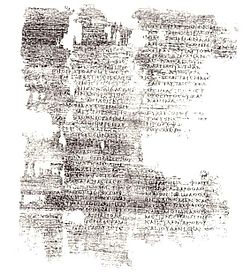- Papyrus 4
-
Manuskripte des Neuen Testaments
Papyri • Unziale • Minuskeln • LektionarePapyrus  4
4Lukas 6,4-16 Zeichen  4
4Text Lukas 1-6 (zu großen Teilen) Sprache griechisch Datum spätes 2./3. Jahrhundert Gefunden Koptos, Ägypten Lagerort Paris, Bibliothèque nationale de France, Suppl. Gr. 1120 Typ Alexandrinischer Texttyp Kategorie I Papyrus 4 (in der Nummerierung nach Gregory-Aland
 4, Teil von Suppl. Gr. 1120) ist eine frühe Handschrift des Neuen Testaments in griechisch. Es ist ein Papyrusmanuskript des Lukasevangeliums und wird auf das späte zweite / frühe dritte Jahrhundert datiert. Zusammen mit P75 ist es eines der ältesten Manuskripte[1] des Lukasevangeliums und enthält große Teile der ersten sechs Kapitel.[2] Zurzeit wird es in der Bibliothèque nationale de France (Suppl. Gr. 1120) in Paris aufbewahrt.[3]
4, Teil von Suppl. Gr. 1120) ist eine frühe Handschrift des Neuen Testaments in griechisch. Es ist ein Papyrusmanuskript des Lukasevangeliums und wird auf das späte zweite / frühe dritte Jahrhundert datiert. Zusammen mit P75 ist es eines der ältesten Manuskripte[1] des Lukasevangeliums und enthält große Teile der ersten sechs Kapitel.[2] Zurzeit wird es in der Bibliothèque nationale de France (Suppl. Gr. 1120) in Paris aufbewahrt.[3] 4 wurde für die Bindung "eines Kodex von Philo verwendet, der im späten 3. Jahrhundert geschrieben wurde. Er wurde in einem Papierkorb gefunden, den man in einem Haus in Coptos (ca. 250) eingemauert hatte.”[4].
4 wurde für die Bindung "eines Kodex von Philo verwendet, der im späten 3. Jahrhundert geschrieben wurde. Er wurde in einem Papierkorb gefunden, den man in einem Haus in Coptos (ca. 250) eingemauert hatte.”[4].Der griechische Text repräsentiert den Alexandrinischen Texttyp. Aland ordnete ihn in Kategorie I ein.[3]
Inhaltsverzeichnis
Datierung
Philip Comfort und David Barret schreiben in ihrem Buch Text of the Earliest NT Greek Manuscripts, dass P4 vom gleichen Kodex wie P64/67 (das Magdalenpapyrus) stamme und datierten den Text auf 150-175 n. Chr.[5] Wieland stimmt vorläufig mit der 'Datierung auf das [3. Jahrhundert] überein, wie auch im NA27. Einige datieren es auf das 2. Jahrhundert (z.B. Roberts und Comfort). Dies ist sehr wahrscheinlich, wenn man die Verwendung des Bindematerials für einen Kodex des 3. Jahrhunderts betrachtet'.[2].
Comfort und Barret zeigen außerdem, dass P4 und [6]. Roberts (1979), Skeat (1997)[7], Wieland[2] und Stanton[8] datieren den Text ebenfalls auf das späte zweite Jahrhundert. Dies führt Gregory zu der Schlussfolgerung, dass 'es gute Gründe gibt, zu glauben, dass P4 ... im 2. Jahrhundert geschrieben sein mag.[7]
Vor kurzem stellte Charlesworth fest, 'dass P64+67 und P4, obwohl vom selben Schreiber geschrieben, nicht aus demselben ... Kodex' stammen.[9]
Siehe auch
Einzelnachweise
- ↑ Gregory (2003) p.28
- ↑ a b c Wilker
- ↑ a b Kurt und Barbara Aland, Der Text des Neuen Testaments. Einführung in die wissenschaftlichen Ausgaben sowie in Theorie und Praxis der modernen Textkritik. Deutsche Bibelgesellschaft, Stuttgart 1989, ISBN 3-438-06011-6, S. 106.
- ↑ Roberts (1979) p. 8: "a codex of Philo, written in the later third century and found in a jar which had been walled up in a house at Coptos [in 250]."
- ↑ Comfort (2001) pp. 50-53, siehe auch (1999)
- ↑ i.e. P. Oxy. 224, 661, 2334, 2404 2750, P. Ryl. 16, 547, and P. Vindob G 29784
- ↑ a b Gregory (2003), p.30
- ↑ Stanton (1997) p. 327
- ↑ Charlesworth (2007), p.604
Literaturverzeichnis
- Charlesworth, SD (2007) T. C. Skeat, P64+67 and P4, and the Problem of Fibre Orientation in Codicological Reconstruction, New Test. Stud. Vol.53, pp. 582–604, doi:10.1017/S002868850700029X
- Comfort, Philip W. "New Reconstructions and Identifications of New Testament Papyri," Novum Testamentum, Vol. 41, Fasc. 3., (Jul., 1999) pp. 214–230.
- Comfort, Philip W. and Barrett, David P. The Text of the Earliest New Testament Greek Manuscripts Wheaton, Ill.: Tyndale House. (2001) pp. 50–53
- Gregory, A. The Reception of Luke and Acts in the Period Before Irenaeus, Mohr Siebeck, (2003) ISBN 3-16-148086-4, p. 28
- Head, PM (2005), Is P4, P64 and P67 the Oldest Manuscript of the Four Gospels? A Response to T. C. Skeat, New Test. Stud. 51, pp. 450–457, doi:10.1017/S0028688505000238
- Roberts, Colin. Manuscript, Society, and Belief in Early Christian Egypt Longwood (June 1979) ISBN 0-85672-710-5 pp. 8+23
- Skeat, TC (1997), The Oldest Manuscript of the Four Gospels?, New Test. Stud. 43, p. 1-34
- Stanton, G. N. (1997), The Fourfold Gospel, New Test. Stud. 43, p. 327
Weblinks
- Willker, Wieland. A Textual Commentary on the Greek Gospels, (undated+unfinished)
Wikimedia Foundation.

